

Japan Onstage
|
Japan has a very long and elaborate history of performing arts. Although old, traditional music and dance forms are still pervasive in everyday life; shamisen music can still be heard on the radio, and communities often unite to dance bon dances together. Theatre is also an ever-popular form of entertainment, with a handful of styles that remain unique to Japan.
Noh (能) is the oldest existing form of Japanese theatre, and is also one of the world’s oldest extant theatrical forms. The history of this theatre form can be traced back to the 8th century, but it was not until the 14th century that it was refined by practitioners, and recognised as a bona fide form of theatre. Noh performances are best known for its use of masks. There are over 400 types of masks used in Noh, with each representing different characters based on gender, age, social ranking, and even their supernatural powers. Based on the angle at which they are seen, each mask can also portray various expressions. Together with masks, performers make use of the elaborate stage, costumes, and subtle gestures to put on a uniquely minimalist-type performance that invites viewers to read between the lines. |
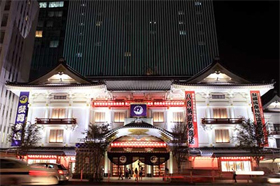 © Web Japan 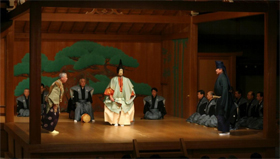 © The Nohgaku Performers’ Association |
|
Kyogen (狂言) is another historical theatre form that developed alongside Noh in Japan. A form of comic theatre, Kyogen used to be performed during the interludes of Noh performances. Unlike the regality of Noh, it is performed in ordinary dress and performers use vernacular speech to deliver witty dialogue. Performers also exaggerate their gestures, and make use of slapstick comedy to inject humour into their short plays.
The theatre form of Kabuki (歌舞伎) is said to have developed in the 1600s, pioneered by a female dance troupe in Kyoto. Later, it developed into a highly stylised all-male theatrical form known for its glamorous costumes and elaborate kumadori makeup worn by some performers. Kumadori makeup starts with a white base, after which, lines are drawn in to dramatise the emotions of the character being portrayed. Each colour is associated with specific meanings, for example, red represents anger, while indigo meant that the character was an evil one. Bunraku (文楽), also known as ningyo joruri (人形浄瑠璃), is a form of puppet theatre that was founded in the city of Osaka during the Edo period. Each doll created for Bunraku theatre is finely crafted and can express nuanced and realistic movements like an actual human being. Three puppeteers are required just to operate one doll, with each having a fixed role; one operates the doll’s legs, another operates the doll’s left arm, and one lead puppeteer controls the doll’s head and right arm. Noh, kyogen, kabuki, and bunraku have all been inscribed on UNESCO’s list of Intangible Cultural Heritage of Humanity, making them collectively the first Japanese performing art forms to be inscribed on the list. Their inclusion on the list underscores the importance of these heritage art forms in Japanese culture. These traditional forms of theatre are also what many non-Japanese think of when they talk about Japanese theatre. |
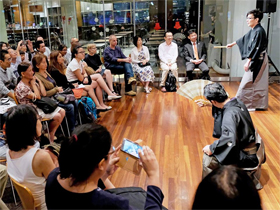 © JCC 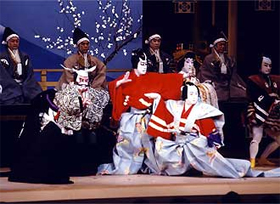 © Agency for Cultural Affairs 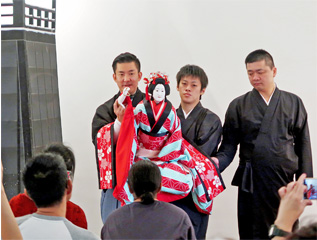 © JCC |
|
Though these historical forms of theatre may have set styles, many contemporary directors have found ways to innovate onstage. For example, some kabuki productions have combined contemporary theatre methods and rock-like music with traditional kabuki techniques to create flamboyant shows that mesmerise theatregoers. Directed by film director Shutaro Oku, particularly ambitious Noh production based on popular media franchise Ghost in the Shell, has even incorporated cutting-edge Virtual Reality (VR) technology to create illusionary effects that enhance the audience’s viewing experience.
With the influence of pop culture in recent years, uniquely Japanese forms of theatre have been innovated. The early 2000s also saw the rapid development of “2.5 Dimensional Musical” theatre performances. Widely abbreviated as 2.5D musicals, these performances refer to modern musical theatre productions that have been adapted from popular Japanese anime, manga, or video games. The famed Takarazuka Revue did stage the first successful production of a play based on a manga (The Rose of Versailles) in 1974, but subsequent musicals based on manga and anime failed to catch on. However, the unexpected popularity of 2003’s Musical: The Prince of Tennis, a production based on the popular manga series The Prince of Tennis, pioneered a boom in 2.5D musicals. Although it opened to middling popularity, Musical: The Prince of Tennis soon attracted large numbers of fans through word-of-mouth. The genre began gaining traction, and many 2.5D musical productions soon followed. Fans of manga and anime series were used to media in 2D, and so seeing their favourite characters and storylines played out on the stage was a thrilling experience. Some productions incorporate audience interactions into their plays, allowing fans to participate with glow sticks just like they would at a concert. The genre also plays with technology in order to immerse fans as deeply as possible into the world of the series they are portraying. In Hyper Projection Engeki: Haikyu!!, based on the manga and anime series Haikyu!!, projection mapping was used to project special manga-style effects onstage, making it seem as though the series’ beloved characters are popping up from the pages of a manga. Because of the global popularity of manga and anime, many of these 2.5D musicals have also garnered a following outside Japan. Productions such as Pretty Guardian Sailor Moon: The Musical, based on the shoujo manga and anime series Sailor Moon, have been performed in conventions in China and the United States. Another production, Live Spectacle NARUTO, based on the shounen series NARUTO has been performed across Asia, in countries such as Singapore, Malaysia, and Macao. The popularity of these musicals in Japan and worldwide also means that these productions have become a novel way for young Japanese performers to get their start in the world of theatre and acting. Even with such a long and illustrious history, Japanese theatre never stops innovating; novel ways of presenting old art forms, and new ways to tell stories in the theatre are being developed constantly. With the abundance of creative troupes and productions, theatregoers are able to enjoy both tradition and modernity, or a harmonious mix of both, on Japan’s stages. |
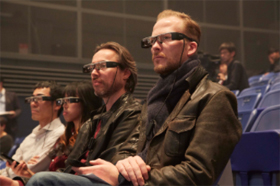 © Web Japan 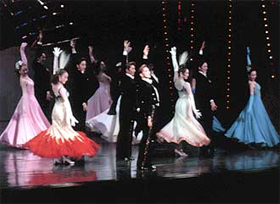 © Takarazuka Revue Company 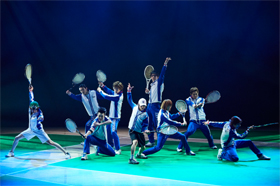 © KT / S・N・STP © KT / S・TM 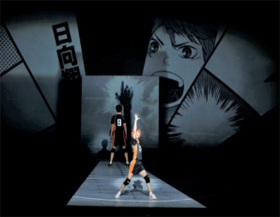 © FH/S ©HF/S・HPEH 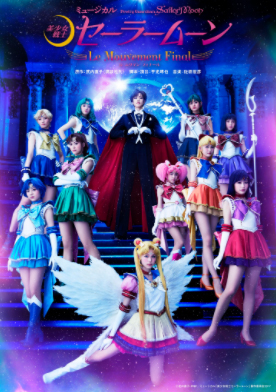 © T・P/MSM2017 |
Resources
|
"2.5 Dimensional Musical" Live Theater. (2017). Retrieved September 14, 2020, from https://web-japan.org/trends/11_culture/pop171214.html |
|
Japan Creative Centre 4 Nassim Road, Singapore 258372 +65 6737 0434 / jcc@sn.mofa.go.jp https://www.sg.emb-japan.go.jp/JCC/ Nearest parking at Orchard Hotel & Delphi Orchard |
 |